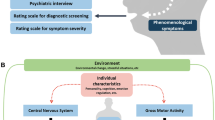Abstract
3 studies investigated the sleep patterns, test-measured anxiety, physiologically measured arousal, and nightmare characteristics of Ss with and without nightmares and implosive therapy therapy treatment of Ss with frequent nightmares. In Study I a questionnaire assessing manifest anxiety, nightmare frequency, and typical sleep patterns was administered. Significant positive relationships were found between nightmare frequency and report of insomnia, manifest anxiety, and various insomniac sleep patterns. In Study II Ss were administered a questionnaire assessing manifest anxiety, nightmare frequency and characteristics, and various sleep patterns; and frontalis electromyogram (EMG) measurements were taken. A significant positive relationship was found between EMG and manifest anxiety, the occurrence of recurrent nightmares, and rate of nighttime awakenings. Study III involved implosive therapy treatment of Ss with histories of frequent nightmares. The Ss demonstrated a clinically significant reduction in nightmare rate and intensity which was maintained at a 3-month follow-up.
Similar content being viewed by others
References
BUDZYNSKI, T. H. 1969. Feedback-induced muscle relaxation and activation level. Unpublished doctoral dissertation, University of Colorado.
CASON, H. 1935. The nightmare dream. Psychological Monographs, 46 (5, Whole No. 209).
CAUTELA, J. R. 1968. Behavior therapy and the need for behavioral assessment. Psychotherapy, 5, 175–179.
FELDMAN, M. J. & HERSEN, M. 1967. Attitudes toward death in nightmare subjects. Journal of Abnormal Psychology, 72, 421–425.
GASTAUT, H., & BROUGHTON, R. 1965. A clinical and polygraphic study of episodic phenomena during sleep. In J. Vostis (Ed.), Recent advances in biological psychiatry. Vol. 8. New York: Plenum Press.
GEER, J. H., & SILVERMAN, I. 1969. Treatment of a recurrent nightmare by behavior modification procedures. Journal of Abnormal Psychology, 72, 188–190.
HAYNES, S. N. FOLLINGSTAD, D. R., & WOODWARD, S. 1974. Insomnia: Sleep patterns and anxiety level. Journal of Psychosomatic Research, 18, 69–74.
HERSEN, M. 1971. Personality characteristics of nightmare sufferers. Journal of Nervous and Mental Disease, 153, 27–31.
HERSEN, M. 1972. Nightmare behavior. Psychological Bulletin, 78, 37–48.
JOHNSON, S. M., & WHITE, G. 1971. Self-observation as an agent of behavior change. Behavior Therapy, 2, 488–497.
JONES, E. 1949. On nightmares. London: Hogarth Press.
KANFER, F. H. 1970. Selfmionitoring: Methodological limitations and clinical applications. Journal of Consulting and Clinical Psychology, 35, 148–152.
LESTER, D. 1968. The fear of death of those who have nightmares. Journal of Psychology, 69, 245–247.
LESTER, D. 1969. Fear of death and nightmare experiences. Psychological Reports, 25, 437–438.
LUTHE, W. 1963. Autogenic training: Method, research, and application in medicine. American Journal of Psychotherapy, 17, 174.
MONROE, L. J. 1967. Psychological and physiological differences between good and poor sleepers. Journal of Observational Psychology, 72, 225–264.
MORUZZI, G. 1960. Synchronizing influence of the brain stem and the inhibitory mechanisms underlying the production of sleep by sensor stimulation. Electroencephalography and Clinical Neurophysiology Supplement, 13, 231–256.
SILVERMAN, I., & GEER, J. M. 1968. The elimination of a recurrent nightmare by desensitization of a related phobia. Behavior Research and Therapy, 6, 109–111.
STAMPFL, T. G.,& LEVIS, D. J. 1967, Essentials of implosive therapy: A learning theory based on psychodynamic behavioral therapy. Journal of Abnormal Psychology, 72, 496–503.
STERNBACH, R. A. 1966. Principles of psychophysiologic. New York: Academic Press.
STOYVA, J., & BUDZYNSKI, T. 1974. Cultivated low arousal — an anti-stress response? In L. V. DiCara (Ed.), Recent advances in limbic and autonomic nervous system research. New York: Plenum.
TAYLOR, J. A. 1953. A personality scale of manifest anxiety. Journal of Abnormal and Social Psychology, 48, 285–288.
Author information
Authors and Affiliations
Additional information
The authors would like to express their appreciation to Mervyn K. Wagner and Diane R. Follingstad for their help in preparation of this manuscript.
Rights and permissions
About this article
Cite this article
Haynes, S.N., Mooney, D.K. Nightmares: Etiological, Theoretical, and Behavioral Treatment Considerations. Psychol Rec 25, 225–236 (1975). https://doi.org/10.1007/BF03394308
Published:
Issue Date:
DOI: https://doi.org/10.1007/BF03394308




